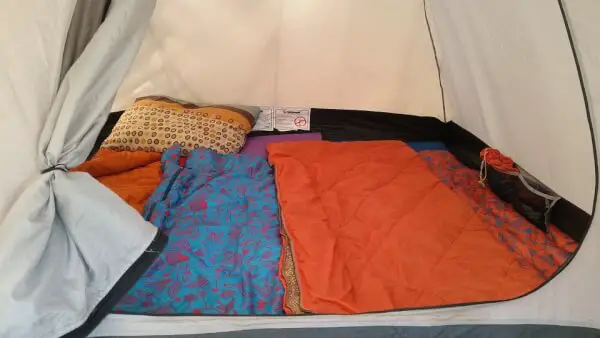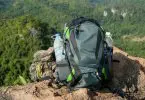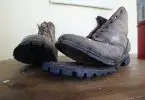Today’s outdoor gear is, in short, phenomenal. The workmanship, the application of technology, the efficiency, everything is undoubtedly progressing and making consumers happy. It is also extremely expensive which is why many outdoorsmen tend to gravitate towards a DIY sleeping bag project.
As improvements in outdoor gear has increased, so too has the price consumers have to pay for the latest and greatest piece of equipment. Quality three-season tents range from $200 to $500 depending on the brand, weight, and number of features.
A good sleeping bag will keep you warm as long as you have over $100 to spend on said sleeping bag. Everything from tents to packs to sleeping bags seem to be priced at higher and higher levels.
Must read: DIY Sleeping Bag Liner: Why Buy a Liner When You Can Make Your Own?
That is why many, in particular habitual thru-hikers, have started making their own gear, customizing it and at a fraction of the cost. The DIY craze hasn’t failed to reach outdoor enthusiasts and many have showcased their DIY tents, sleeping bags and even DIY camper vans. Though it may take longer and frustrate you, the benefits of making your own outdoor equipment can far outweigh said time and frustration.
Below we’ll show you how to make your own sleeping bag for less as well as things to consider before venturing out to make your own outdoor equipment.
Before You Start Stitching
There’s a few things you need to consider before you start sewing together your next sleeping bag, many of which are obvious. Things such as materials, thread, insulation, and your sewing ability should all be considered prior to deciding to make your own sleeping bag.
Style
First and foremost, you’ll want to decide what type of sleeping bag you want to make, whether it’s a traditional, mummy, or quilt style bag.
The style of the bag will determine almost everything, materials, amount of insulation, zipper type, zipper length, and, most importantly, cost.
So before you do anything else, choose what style of bag you want to create. Once you do that, you can choose the pattern, materials, and insulation without having to buy more than you need.
Materials
This may be the most important thing to consider prior to diving into making your own sleeping bag, as it will determine the cost, weight, and feasibility of your project. There are many different types of material that you can use for the interior and exterior of you sleeping bag, all with different costs.
The outer and inner shells don’t typically get as much wear and tear as packs, tents or other gear that you generally use outside. As a result, you can pick the most lightweight materials available without much worry about a lack of durability. This can save you a lot of weight, a pound in some cases, for your overall base weight.
The most common material for most sleeping bags is some sort of Nylon or polyfiber blend, though there are lighter materials available. A popular material for a lot of outdoor gear is Cuben fiber which has the lowest weight per square inch and has the added benefit of being waterproof. The problem with Cuben fiber as a sleeping bag, however, is the amount of noise produced when the material moves.
The most recommended material, and the material we would recommend, is any variation of nylon ripstop material. It’s lighter and cheaper than most polyfiber materials and will have just enough to protection to give you peace of mind about your sleeping bag’s durability. The synthetic material is also water resistant which is great for keeping condensation away from your insulation.
Most of the material you’ll need for the outer and inner layers of the sleeping bag can be found at your local fabric store or online. Generally, you can find better deals at online outlets than you can at local stores, however, it’s a good idea to shop around so you can actually save money by making your own bag.
Another fabric you’ll have to make a decision about is the material for your baffles, or the small pockets that hold the insulation and keep it from shifting or clumping in one place. This material, though less important than the outer material, should be considered carefully. The most common material used is a a lightweight mesh material, meant to be sturdy enough to continually keep the insulation in place, though not so sturdy as to prevent airflow between the individual feathers.
The size of the mesh’s openings is also something to pay attention to as too big and the feathers will escape and won’t insulate at all. Too small and the bag will become too heavy and will prevent the very airflow needed to keep proper insulation. It’s also important not to pack the baffles too tight, though we’ll get into that a little further along.
Insulation
This is the bread and butter of your sleeping bag, the whole reason you have a sleeping bag in the first place, it’s what keeps you warm when using your sleeping bag. As such, you should take your time and conduct considerable research as to which insulation type is right for you. The type of insulation will be a huge factor in the weight, cost, and overall heat retention of your sleeping bag when all is said and done.
There are many different types of insulation, however, we’ll be talking about the two most common and most used types: synthetic and down. There’s a variation of down that we’ll also be talking about that has many of the benefits of synthetic insulation but more on that later.
Down
The most common and lightweight type of insulation is down, a mixture of goose and duck feathers packed together in order to prevent heat loss. Down has become more and more popular, particularly among thru-hikers and long-distance backpackers because of its weight, or lack there of. The down works by using the gaps between the individual feathers and the strands on each feather to create an air pocket that traps the heat and prevents it from escaping.

A drawback to down is its inability to insulate once the feathers have gotten wet. Though it is slightly water resistant, it doesn’t take much to saturate the feathers. To combat this, many outdoor companies and thru-hikers treat the down in a special solution to increase its resistance to moisture.
See also: Duck Down vs. Goose Down: Which One Is Superior?
If cost isn’t a huge obstacle and weight is one of the most important factors, treated down will most likely be your best option for insulation.
Synthetic
Synthetic insulation is similar to many household quilts and blankets, that is, it’s a water resistant, synthetic material. Though a bit heavier, synthetic is a great bargain option as it provides adequate heat at a fraction of the cost. Unfortunately, it is much, much heavier than its down counterpart and can become a burden.
Because it doesn’t retain heat as well as down, more insulation is required in order to obtain the same temperature rating, thereby making it significantly heavier. The good news is synthetic insulation will still retain heat even after it has become saturated with moisture.
Other Materials
There are a couple minor materials you’ll need to think about and buy before you start construction your sleeping bag, namely zippers and snaps. The style of bag you choose will determine what type of zipper you get or, in the case of the quilt, the number of snaps and drawstrings you’ll want to get. Most mummy style bags use a ¾ length zipper, meaning you’ll have to get the correct length of zipper prior to buying. The length, of course, is ultimately up to you and what your personal preferences are.
Snaps are one of those accessories that aren’t entirely necessary but they make a great deal of difference. On quilts and mummy bags, snaps are a common accessory for helping to keep the bag, in particular the upper portion of the bag, in place while you sleep. For mummy bags, this snap is usually near the bottom of the hood and helps keep it contouring to your head so you can retain heat much better.
Pattern
There are hundreds of ideas for patterns pasted all over the internet, most of which will work if used correctly. The best way to make a pattern for a sleeping bag is by using newspaper or some larger type of paper. It’s cheap, easy, and it won’t be the end of the world if you mess up. You can also buy a pattern though these will cost you between $30-40 and generally render your DIY sleeping bag more expensive.
When drawing the pattern make sure that the width of the pattern measures between 59-62 inches at the shoulders and 56-59 inches at the hips for a tapered mummy bag. For quilts and traditional bags, you’ll want to make sure you leave enough room for both your hips and your shoulders with adequate space for moving around while using your bag.
Length for a mummy bag is dependent upon the person and a great way to know your desired length is to measure from your nose to the floor and add about two inches. Also remember to add a semi-circular top to the bottom pattern when making a mummy bag as you’ll want to make sure you have adequate length to put the bag over your head. You’ll want to add about eighteen inches for this.
It’s important to remember to either melt the edges of the fabric after cutting them to prevent fraying or to use a heat knife to cut the fabric. This will save you a lot of frustration and aggravation when sewing your bag together.
Baffles
The pattern of your baffles will greatly depend on the style of baffle you want to use, whether it be the “V” baffle, the slanted baffle, or the box baffle.
The V baffle uses three sides to hold the insulation while the box and slanted baffles use four. For all of them you’ll want the length of each baffle to be around three and a half inches so when making a pattern for the V baffle you’ll want to measure out ten and a half inches and for the slanted and box baffles you’ll want to measure fourteen inches.
To construct the baffles simply divide each length of material into thirds or quarters depending on the style and stitch along that line to give it a pocket like shape. It helps if you take about 1/8 of inch on each side of the line and pinch them together when stitching. This will greatly increase the structural integrity of the baffle’s shape.
Stitching
It’s important to remember when stitching both the baffles and the bag itself, not to use to large a thread or needle. Doing so can lead to leakage from the baffles and the bag and will ultimately retain less heat. When stitching the baffles it is important to use a smaller thread count as this will help the insulation keep it’s fluff without leaking feathers.
Construction
- Now it’s time to get to sewing everything together and making your sleeping bag look like a sleeping bag. After constructing your baffles, you’ll want to draw lines on both the inside and outside of the outer shells. It’s easiest to sew the baffles to the inner shell first though in the end it doesn’t really matter. Make sure you sew the baffles to both the inner and outer shells to prevent movement from the baffles and the insulation.
- If you’re making a mummy bag make sure you measure the baffles for the hip and shoulder girth lengths and mark them in some way so you know which is which. Some may find it easier to make one baffle at a time and sew it to the inside of the shell before moving on to the next baffle.
- Once both the top and bottom shells have been constructed you’ll want to sew the foot box of the sleeping bag first. To do this you can either create a separate piece of fabric with one baffle spanning the entire area or you can sew the ends of the top and bottom together. Either way, start at the bottom and work your way up.
- For mummy bags with a ¾ zip, you’ll want to measure out the length of the zipper on the bag and mark it’s end prior to sewing up the bag. Once you’ve sewn to the marked portion of the bag, sew the zipper into the bag and connect the bottom of the zipper to the top edge of the bag’s seam.
- Once the zipper side is complete, continue sewing up the opposite side of the bag. Once you’ve reached the bottom of the hood on a mummy bag, it is a good idea to use a double stitch where the hood and the top layer are connected. This portion of the bag is one of the biggest stress points and is often where degradation in the seams and material occurs.
- To complete the hood you have the option of putting in an elastic draw string to tighten the hood around your face on those particularly cold nights. To do this sew a ¼ inch channel spanning the entirety of the rim of the hood. Cut a small hole in the channel to allow you to pull the drawstring without having an annoying length of elastic cord hanging from one side or the other. After you insert the drawstring, sew the ends to each endpoint of the hood. Pull a portion of the drawstring from the hole in the channel and use a barrel lock to keep the hood tight.
- By now your sleeping bag should be looking almost like a sleeping bag you’d buy. There are several other options, such as a hook and loop strap over the zipper to keep it in place while in use. These types of extras should be done once the majority of the bag is complete.
- An optional finishing touch is seam sealing the zipper which most agree is one of the easiest ways to prevent heat loss from the zipper seam. To do this, use either a glue-based solution or seam tape. The former is more durable and more convenient for a sleeping bag as it will remain as flexible as the material itself.
- Once complete, the only thing left to do is to weigh your sleeping bag and take it out for a test run in the back yard. Depending on the types of materials you use, your new lightweight sleeping bag should total around $90 not including the time it takes you to construct it.
Final thoughts
As you can see, making your very own sleeping bag is not exactly rocket science but it does require a fair bit of work and dedication on your part. If you manage to make your own sleeping bag, you can just imagine the savings as well as the sense of accomplishment that you’ll feel.
Already made your own sleeping bag and have some tips that might help? Tell us about them in the comments section. For more easy instructions on how to make a DIY camping gear, check out our earlier article to find out.
Featured Image Source: https://pixabay.com/photos/tent-sleeping-bags-camping-1345673/








